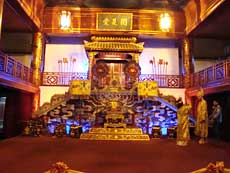Duyet Thi Duong - the Royal Theater is the oldest of the Vietnamese traditional stages that remain today

One of two royal theatres in Huế, Duyet Thi Duong Royal Theatre was built by King Tu Duc (1848-1883) for performances of royal music, dance and
tuồng.
Recently it has been restored with the assistance of UNESCO, the theatre is now once more used for performances of royal music and dance, tuồng opera and the traditional music of Huế, with four 30-minute performances presented daily by members of the Huế Royal Palace Arts Troupe.
The Royal Theater was built by Emperor Minh Mang in 1826. It is located in the east of the Quang Minh Palace (Palace of Brightness) in the Forbidden Citadel. It is large, rectangular-shaped with curved eaves, similar to those of Hue pagodas and communal houses, supported by two rows of iron-wood, red lacquered columns decorated with intertwined dragon and cloud designs. On each column hung a painting of Hue scenery in a golden frame, carved with dragon designs. The sky-blue ceiling above was painted with figures of sun, moon and stars, symbolizing the universe. The building was connected with the royal living quarters by snake roofed galleries.
Nha nhac, the court music of Hue was performed during important ceremonies of the court such as the Nam Giao Ritual, Xa Tac Ritual, coronation ceremonies, congratulations for the king’s longevity and reception ceremonies for ambassadors. Hue court music has been recognized by UNESCO as an Oral Masterpiece and an Intangible Cultural Heritage of Humanity.
In Hue, besides visiting interesting mausoleums, the World Cultural Heritage Site, visitors are also eager to enjoy the essence of Vietnamese traditional music.
There are four theatres built in the 143 years of Nguyen Dynasty’ rule (1802 – 1945). Duyet Thi Duong was built in the 7th year of Minh Mang (1826) and was the first theatre of Nguyen Dynasty. The next, Tinh Quan Vien, was built in 1843 under King Thieu Tri. The Minh Khiem Duong theatre was built in 1865 under Tu Duc King and the last, Cuu Tu Dai, was built in 1917 under King Khai Dinh’s control.
A square-shaped stage occupied the central part of the floor. No decoration was used to distinguish the real world from the theatrical one. Behind the stage were two doors. Actors and actresses made their entrances from the right-side and exited on the left. Behind the wall was a large room for storing scripts, theatrical headgear, footwear and props. The highest position of this room was occupied by an altar dedicated to two founders of the court opera theater. The room opened onto the court east of the Forbidden Citadel (this entrance was used by actors and actresses).
Across the stage was a high tower of two levels. The top level, next to the western wall, was reserved for the queen, concubines and maidservants. On the ground level was a carved chair for the Emperor. These two levels were kept separated by a bamboo blind which offered the spectators a good view of the outside, preventing them from being seen. Only the fluttering sounds made by fans, such as birds’ wings, or giggles could sometimes be heard.
Currently, Duyet Thi Duong is a space for performing Nha Nhac by the Hue Royal Fine Art Association (belonging to the Center for Preservation of Hue Ancient Capital). On average, there are 4 performances per day, and there are over 2,500 visitors to Duyet Thi Duong to enjoy Hue traditional arts every month, the majority are international visitors. Duyet Thi Duong’s significance is most apparent during festivals when it becomes the main attraction.